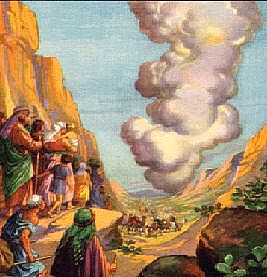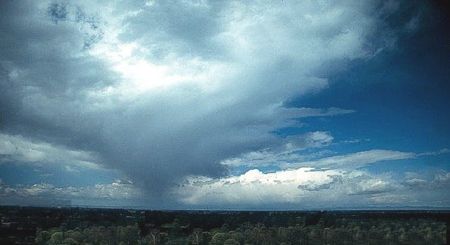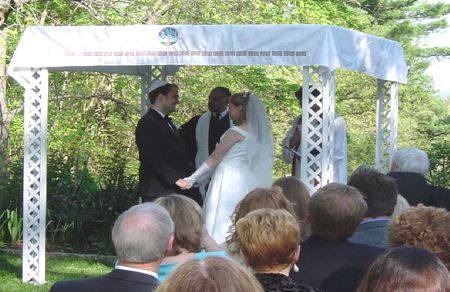|
A Pillar of Fire and a Cloud Israel's Guiding Light Moreover thou leddest them in the day by a cloudy
pillar; Carl Hagensick The Sinai wilderness presented Israel with a daunting challenge. There was the scorching heat by day and the chills of the desert night air. The valleys and wadies were unmapped. There were perils of predatory animals and scorpions with their poisonous sting. Marauding nomads could not be anticipated. The Amalekites, who claimed the wilderness as their private ground for herding their sheep and their goats, were territorial and aggressive. Indeed, the challenge was daunting. Israel’s God and Guide Almost immediately after leaving Egypt God miraculously guided the Israelites by creating a special cloudy and fiery pillar to move in the vanguard of the two-million-man march: “And the LORD went before them by day in a pillar of a cloud, to lead them the way; and by night in a pillar of fire, to give them light; to go by day and night: He took not away the pillar of the cloud by day, nor the pillar of fire by night, from before the people” (Exodus 13:21,22). What a sight this was: an all-night fire with no fuel; a daytime cloud sitting still despite shifting winds; a moving cloud zigzagging through the wilderness in the face of contrary breezes! It was, truly, a daily and nightly reminder of God’s guiding power. It was a phenomenon, never to be repeated, that existed only as long as needed, until the promised land was reached! It was not only for the sake of Israel, but also as a witness to the surrounding nations that Israel’s God was wise, powerful, and protective of his chosen people: “And they will tell it to the inhabitants of this land: for they have heard that thou LORD art among this people, that thou LORD art seen face to face, and that thy cloud standeth over them, and that thou goest before them, by day time in a pillar of a cloud, and in a pillar of fire by night” (Numbers 14:14). At the Red Sea This cloud played a major role at the shores of the Red Sea. Trapped, with mountains looming on the right and the left, the waters of the Red Sea in front, and a formidable host of Egyptian troops rapidly advancing from the rear, it seemed as if the Israelites had no way out of their predicament. It was then, in the dark of night, that their guiding pillar lifted and moved from the front to the rear of the Israelite horde, placing itself between the frightened encampment and its pursuers. The fiery column transformed itself into simultaneous light and darkness; the dark side hiding the fleeing horde from the Egyptian forces, while the bright light on the reverse side provided light for the Israelites to hastily prepare for the delivering miracle that lay ahead. “And the angel of God, which went before the camp of Israel, removed and went behind them; and the pillar of the cloud went from before their face, and stood behind them: and it came between the camp of the Egyptians and the camp of Israel; and it was a cloud and darkness to them, but it gave light by night to these: so that the one came not near the other all the night. ... And it came to pass, that in the morning watch the LORD looked unto the host of the Egyptians through the pillar of fire and of the cloud, and troubled the host of the Egyptians.”—Exodus 14:19,20,24 Hobab Subsequently, as they apprehensively faced the intimidating challenges of an unfamiliar wasteland through which they would journey, Moses sought assistance. It was not as if an individual were traversing the wilds alone, or even a group of merchants traveling in caravan; but Moses was responsible for the safe journey of an entire nation of some two million people. The valleys would need to be wide for the herds and flocks, the soil must not be too sandy lest it bog down wagons laden with household possessions, water must be available to prevent dehydration of man and animal. Difficult decisions must be made, for which wilderness intelligence would be needed. For this reason Moses turned to a trusted relative who had made his living for a lifetime in this barren land, his brother-in-law (or father-in-law, see Judges 4:11), and asked him to be their guide. Moses responded to an initial refusal with a further plea: “And he said, Leave us not, I pray thee; forasmuch as thou knowest how we are to encamp in the wilderness, and thou mayest be to us instead of eyes. And it shall be, if thou go with us, yea, it shall be, that what goodness the LORD shall do unto us, the same will we do unto thee” (Numbers 10:31,32). Hobab accepted. They had been at Mount Sinai for some time, and now the Israelites resumed their journey: “They departed from the mount of the LORD three days’ journey: and the ark of the covenant of the LORD went before them in the three days’ journey, to search out a resting place for them. And the cloud of the LORD was upon them by day, when they went out of the camp” (Numbers 10:33,34). Had Moses lost faith in the guiding providences of the cloud of the Lord, or was it a case of the cloud showing the general direction and destination and Hobab delineating the best route to get there? That is one of many unanswered questions in the sacred record. The Door of the Tabernacle Apparently the usual resting place of the cloud was over the Most Holy of Israel’s tabernacle. It is theorized by some that the Shekinah light, that shone between the two golden cherubim perched on the Ark of the Covenant, was caused by an interaction between the electrically-charged cloud and the Mercy Seat with its two carved angelic figures. If this conjecture is correct, it shows that divine wisdom, represented in the light, is a product of God, whose presence was indicated by the cloud, and the harmonious balance between the attributes of love and power, shown in the cherubim, and justice, represented by the Mercy Seat itself. On occasion, however, when God wished to make a pronouncement to his chosen people, the cloudy pillar moved and took up a position at the door of the tabernacle. It is likely this “door” was the entrance to the Holy of the tabernacle, though some believe it was the curtain leading into the outer court. Three such occasions are mentioned: Exodus 33:9,10; Numbers 12:5; Deuteronomy 31:15. The Shape of the Cloud There are two thoughts as to the shape of this miraculous cloud. Some view it as an upright plume as suggested by the word “pillar” as shown here:
Others envision it more as a canopy similar to the cloud in this picture:
A text in Isaiah may shed some light on this question: “Then the LORD will create over the whole site of Mount Zion and over her assemblies a cloud by day, and smoke and the shining of a flaming fire by night; for over all the glory there will be a canopy and a pavilion. It will be for a shade by day from the heat, and for a refuge and a shelter from the storm and rain” (Isaiah 4:5,6, RSV). This text describes the cloud as a “canopy” that provided both “shade by day from the heat” and as “a refuge and a shelter from the storm and rain.” This implies a huge cloud for the massive horde of two million people, about the population of Houston, Texas, which covers nearly six hundred square miles. Into this equation one must add space for the flocks and herds. These expressions assign two functions: one was to provide shelter from the oppressive desert heat, the other was to provide shelter from the rain. This again demonstrates another special feature of this cloud. Usually clouds bring rain, not shelter from rain. Clouds are porous and thus incapable of keeping out rain. But this miraculous pillar prevented not only the nuisance of a downpour but also flash floods from rushing down the baked desert wadies. And it kept the ground from being saturated with water which would prevent the movement of the wagons. A Bridal Canopy The one Hebrew word translated “a pavilion and a canopy” (“defense” in the KJV) is chuppah (Strong’s #2646). It literally means “covering” or “canopy.” The word chuppah is still used today by the Jews to describe the embroidered canopy under which weddings are performed.
This Hebrew word is found in two other places in the Old Testament: Psalm 19:5 where it is translated “chamber” in the KJV, and Joel 2:16 where it is rendered “closet.” Its significance in the Jewish wedding ceremony had a slightly different significance in biblical times. Today it represents the new home the couple will make for themselves. In ancient times, however, the entrance into the chuppah marked the actual union of bride and groom; it also signified their trust in divine protection. It is in this latter signification that it is used in reference to the fiery pillar. The dangers of the harsh and foreboding Sinai wilderness were sufficient to make anyone apprehensive. But the sight of the column of fire by night and overhanging cloud by day was a constant assurance that the God who had delivered them from the ruthless hands of their Egyptian taskmasters was surely able to protect them in the stark desert. Oh, if they only believed! How forceful this lesson should be to the Christian today: His wisdom will not lead us where his grace cannot keep us. Faith can firmly trust him, Come what may! Inspiration for Future Generations Over a thousand years after they arrived in the promised land, in the fresh zeal inspired by Nehemiah, the Israelites who had returned from Babylon observed the Feast of Tabernacles. This feast, also called Succoth, was to commemorate the protection God provided in the wilderness and it may have marked the cessation of the fiery pillar. The whole population was divided into eight groups and each was led in the same or similar prayer by eight Levites whose names are given in Nehemiah 9:5. On two occasions in that prayer of thanksgiving for divine protection in their exodus from Babylon, the prayer refers to the guidance and protection provided by the pillar of fire and cloud: “Moreover thou leddest them in the day by a cloudy pillar; and in the night by a pillar of fire, to give them light in the way wherein they should go. ... Yet thou in thy manifold mercies forsookest them not in the wilderness: the pillar of the cloud departed not from them by day, to lead them in the way; neither the pillar of fire by night, to shew them light, and the way wherein they should go.” (Nehemiah 9:12,19). The psalmist likewise draws inspiration from the guiding light: “Moses and Aaron among his priests, and Samuel among them that call upon his name; they called upon the LORD, and he answered them. He spake unto them in the cloudy pillar: they kept his testimonies, and the ordinance that he gave them” (Psalm 99:6,7). “Holy Spirit, Faithful Guide” Though there is no literal pillar of fire or cloud to provide such protection and guidance in a Christian’s wilderness journey, he is not without his guiding light. All of the functions provided by this miraculous pillar are given through the holy spirit:
As the Levites of Nehemiah’s day thanked the Lord for the fiery pillar that led their forefathers safely to the promised land, let us ever sing our thanks for the guidance and protection we daily receive through the holy spirit.
|


